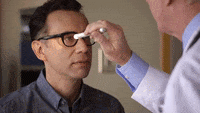Is it becoming challenging to see out of the side of your eye? Have you noticed sudden changes in your vision?
One of the sneakiest eye conditions is glaucoma. Both of these signs could be symptoms of it.
Glaucoma is so sneaky because it has no warning signs. It can cause vision loss before you know you have it.
This fact has earned glaucoma the nickname the silent thief of sight. Keep reading to learn more about glaucoma and why you should consider MIGS.
What is Glaucoma?
Glaucoma is a group of eye conditions that damage the optic nerve. Without a healthy optic nerve, clear sight is impossible.
Glaucoma damages your optic nerve by increasing your eye pressure or IOP. The increase in IOP is the result of a block somewhere in your eye’s drainage network.
This block keeps fluid from leaving your eye and slowly increases the pressure in your eye over time. Eventually, enough fluid will build up, and your IOP will get so high that it presses on your optic nerve.
When the pressure pinches your optic nerve, it can get damaged. Damage to your optic nerve is permanent, and without proper treatment, it can cause total vision loss.
What are the Risk Factors for Glaucoma?
Glaucoma can affect anyone at any time. The root cause of the disease is not fully understood.
But, certain things can increase your chances of developing glaucoma. Some of these risk factors include:
Being sixty years old or olderHaving naturally high eye pressureNearsightedness and farsightednessA family history of glaucomaHispanic, Asian, or African heritageCertain medical conditions like diabetes and othersSmall corneasEye injurySide effects from eye surgeryLong term use of steroid eye drops
This list is not exhaustive, but being aware of these factors can help you lead a healthier lifestyle. If you’d like to reduce your chances of developing glaucoma, leading a healthy life is the easiest thing you can do.
How Does Glaucoma Work?
Unlike other eye conditions, the most common types of glaucoma do not have warning signs. This fact is why it can suddenly appear and seemingly steal your sight.
Unfortunately, it is common for people to realize their vision has changed after it’s too late. Also, unlike most other eye conditions, damage from glaucoma is irreversible. Once it begins, there is no way to fix it.
If you have glaucoma, your only option is to keep your IOP low with treatments and visits to your eye doctor. Frequent eye exams are the number one way to prevent vision loss from glaucoma.
During your eye exam, your doctor will measure your IOP so that they can track changes over time. Having a baseline IOP is vital because it shows your eye doctor any dramatic changes in IOP.
Catching glaucoma early is crucial to keeping your eyesight. The sooner diagnosis occurs, the sooner you can get treatment to help prevent or delay vision loss.
What are the Symptoms of Glaucoma?
There are two main types of glaucoma, and both have different symptoms and timelines. It is essential to know the signs and symptoms of both types to be aware of vision changes.
Acute angle Glaucoma
Acute angle glaucoma has a range of symptoms and rapid onset. Also called acute angle-closure glaucoma, this is the less common of the two primary types of glaucoma.
Its symptoms include:
Strong headachesEye painNausea and vomitingCloudy visionHalos around lightsRed eyes
Acute angle glaucoma is a medical emergency. It can cause complete vision loss without immediate treatment.
If you suspect you are having an acute angle glaucoma attack, contact a medical professional.
Open-angle Glaucoma

Also called primary open-angle glaucoma (POAG), this is the most common type of glaucoma. Its symptoms appear in the later stages, usually after vision damage has occurred.
When this type of glaucoma has advanced, its primary symptom is tunnel vision. Tunnel vision indicates blind spots in your peripheral vision.
If you are getting tunnel vision from POAG, it is likely that you already have optic nerve damage.
How Do You Treat Glaucoma?
Traditional glaucoma treatments were medications and surgery. Eyedrop or oral medications can be effective at reducing IOP, but often you need more than one.
Surgery is also effective but can be high risk and requires a recovery period. But, recent developments have made treating glaucoma easier and less intense.
Minimally invasive glaucoma surgeries (MIGS) have become more common recently. These straightforward procedures give you an alternative to reduce IOP. They are less intense than glaucoma surgery and can help reduce your dependence on medications.
Should You Consider MIGS?
You can combine many MIGS procedures with cataract surgery. iStent Inject and Kahook Dual Blade Goniotomy are two standard MIGS procedures.
Both can be stand-alone procedures or completed during cataract surgery. And both effectively reduce IOP.
During cataract surgery, your surgeon creates an incision in your cornea. Your lens gets removed through this incision, and your replacement IOL goes in through it.
After your natural lens is out and before your IOL goes into your eye, the MIGS procedure occurs. Both MIGS procedures use this incision created during cataract surgery.
When your natural lens is not in your eye, your surgeon can access your drainage network. This is when the iStent Inject devices can get placed in your trabecular meshwork.
The meshwork is a soft tissue that eye fluid flows through. It could be the cause of fluid backup if you have glaucoma.
The iStent procedure implants two tiny devices in the meshwork. They provide a new drainage path for eye fluid to flow through your meshwork.
Kahook Dual Blade Goniotomy also can occur when there is no lens in your eye. It is a unique device that removes tissue from your drainage network.
Removing this tissue should give your eye fluid more space to drain out of your eye. It is easy to access this tissue with the dual-blade during cataract surgery.
Both of these MIGS procedures can also be stand-alone procedures. Either way, though, an incision gets made in your cornea, so it is easy to do during cataract surgery.
Get Frequent Eye Exams to Keep Your Eyesight
 Remember, changes in your sight and eye health can be so tiny that you don’t notice them. Getting frequent eye exams is the only way to catch glaucoma early.
Remember, changes in your sight and eye health can be so tiny that you don’t notice them. Getting frequent eye exams is the only way to catch glaucoma early.
If left untreated, glaucoma will cause vision loss.
Do you need an eye exam? Schedule an appointment at Chicago Cornea Consultants in Chicago, IL, to ensure your eyes are safe!

